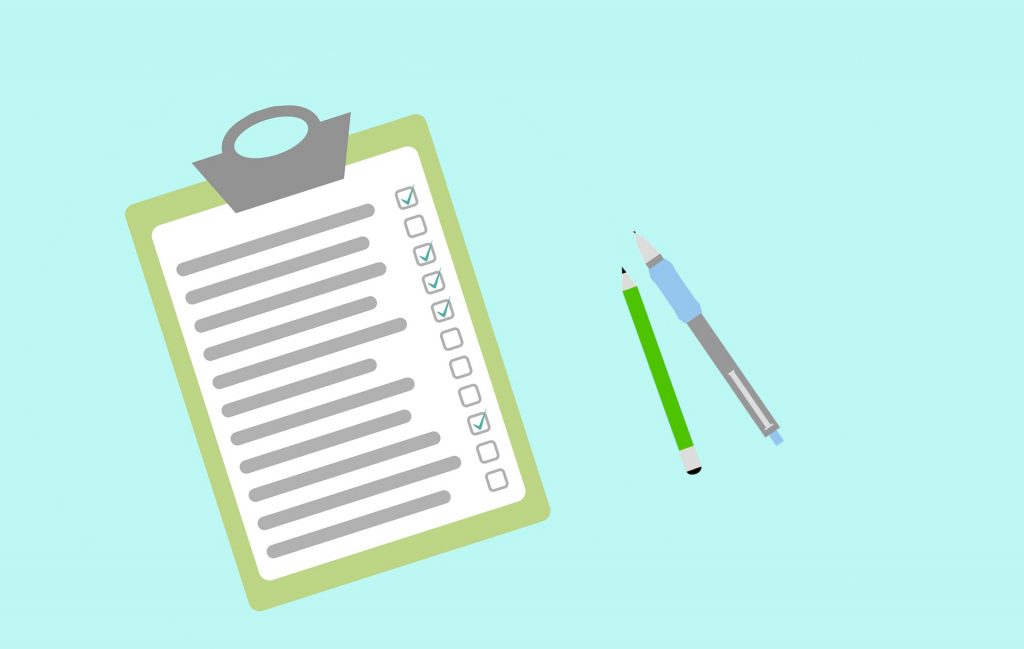12.1 What is survey research, and when should you use it?
Learning Objectives
Learners will be able to…
- Distinguish between survey as a research design and questionnaires used to measure concepts
- Identify the strengths and weaknesses of surveys
- Evaluate whether survey design fits with their research question
Pre-awareness check (Knowledge)
Have you ever been selected as a participant to complete a survey? How were you contacted? Would you incorporate the researchers’ methods into your research design?
Researchers quickly learn that there is more to constructing a good survey than meets the eye. Survey design takes a great deal of thoughtful planning and often many rounds of revision, but it is worth the effort. As we’ll learn in this section, there are many benefits to choosing survey research as your data collection method. We’ll discuss what a survey is, its potential benefits and drawbacks, and what research projects are the best fit for survey design.
Is survey research right for your project?
To answer this question, the first thing we need to do is distinguish between a survey and a questionnaire. They might seem like the same thing, and in normal non-research contexts, they are used interchangeably. In this textbook, we define a survey as a research design in which a researcher poses a set of predetermined questions to an entire group, or sample, of individuals. That set of questions is the questionnaire, a research instrument consisting of a set of questions (items) intended to capture responses from participants in a standardized manner. Basically, researchers use questionnaires as part of survey research. Questionnaires are the tool used in conducting survey research. Surveys, on the other hand, do not measure the impact of an intervention or stimulus introduced by the researcher. Instead, surveys look for patterns that already exist in the world based on how people self-report on a questionnaire. Self-report simply means that the participants in your research study are answering questions about themselves, regardless of whether they are presented on paper, electronically, or read aloud by the researcher. Questionnaires structure self-report data into a standardized format—with everyone receiving the exact same questions and answer choices in the same order[1]—which makes comparing data across participants much easier. Researchers using surveys try to influence their participants as little as possible because they want accurate answers.
Surveys, on the other hand, do not measure the impact of an intervention or stimulus introduced by the researcher. Instead, surveys look for patterns that already exist in the world based on how people self-report on a questionnaire. Self-report simply means that the participants in your research study are answering questions about themselves, regardless of whether they are presented on paper, electronically, or read aloud by the researcher. Questionnaires structure self-report data into a standardized format—with everyone receiving the exact same questions and answer choices in the same order[1]—which makes comparing data across participants much easier. Researchers using surveys try to influence their participants as little as possible because they want accurate answers.
Questionnaires are completed by individual people, so the unit of observation is almost always individuals, rather than groups or organizations. Generally speaking, individuals provide the most informed data about their own lives and experiences, so surveys often also use individuals as the unit of analysis. Surveys are also helpful in analyzing dyads, families, groups, organizations, and communities, but regardless of the unit of analysis, the unit of observation for surveys is usually individuals.
In some cases, getting the most-informed person to complete the questionnaire may not be feasible. As we discussed in Chapter 2 and Chapter 6, ethical duties to protect clients and vulnerable community members is important. The ethical supervision needed via the IRB to complete projects that pose significant risks to participants takes time and effort. Sometimes researchers rely on key informants and gatekeepers like clinicians, teachers, and administrators who are less likely to be harmed by the survey. Key informants are people who are especially knowledgeable about the topic. If your study is about nursing, you would probably consider nurses as your key informants. These considerations are more thoroughly addressed in Chapter 10. Sometimes, participants complete surveys on behalf of people in your target population who are infeasible to survey for some reason. Some examples of key informants include a head of household completing a survey about family finances or an administrator completing a survey about staff morale on behalf of their employees. In this case, the survey respondent is a proxy, providing their best informed guess about the responses other people might have chosen if they were able to complete the survey independently. You are relying on an individual unit of observation (one person filling out a self-report questionnaire) and group or organization unit of analysis (the family or organization the researcher wants to make conclusions about). Proxies are commonly used when the target population is not capable of providing consent or appropriate answers, as in young children.
Proxies are relying on their best judgment of another person’s experiences, and while that is valuable information, it may introduce bias and error into the research process. For instance, If you are planning to conduct a survey of people with second-hand knowledge of your topic, consider reworking your research question to be about something they have more direct knowledge about and can answer easily.
Remember, every project has limitations. Social work researchers look for the most favorable choices in design and methodology, as there are no perfect projects. A missed opportunity is when researchers who want to understand client outcomes (unit of analysis) by surveying practitioners (unit of observation). If a practitioner has a caseload of 30 clients, it’s not really possible to answer a question like “how much progress have your clients made?” on a survey. Would they just average all 30 clients together? Instead, design a survey that asks them about their education, professional experience, and other things they know about first-hand. By making your unit of analysis and unit of observation the same, you can ensure the people completing your survey are able to provide informed answers.
Researchers may introduce measurement error if the person completing the questionnaire does not have adequate knowledge or has a biased opinion about the phenomenon of interest. [INSERT SOME DISCUSSION HERE, FOR EXAMPLE GALLUP OPINION POLLS, ELECTION POLLING]
In summary, survey design tends to be used in quantitative research and best fits with research projects that have the following attributes:
- Researchers plan to collect their own raw data, rather than secondary analysis of existing data.
- Researchers have access to the most knowledgeable people (that you can feasibly and ethically sample) to complete the questionnaire.
- Individuals are the unit of observation, and in many cases, the unit of analysis.
- Researchers will try to observe things objectively and try not to influence participants to respond differently.
- Research questions asks about indirect observables—things participants can self-report on a questionnaire.
- There are valid, reliable, and commonly used scales (or other self-report measures) for the variables in the research question.

Strengths of survey methods
Researchers employing survey research as a research design enjoy a number of benefits. First, surveys are an excellent way to gather lots of information from many people and is cost-effective due to its potential for generalizability. Related to the benefit of cost-effectiveness is a survey’s potential for generalizability. Because surveys allow researchers to collect data from very large samples for a relatively low cost, survey methods lend themselves to probability sampling techniques, which we discussed in Chapter 10. When used with probability sampling approaches, survey research is the best method to use when one hopes to gain a representative picture of the attitudes and characteristics of a large group.
Survey research is particularly adept at investigating indirect observables or constructs. Indirect observables (e.g., income, place of birth, or smoking behavior) are things we have to ask someone to self-report because we cannot observe them directly. Constructs such as people’s preferences (e.g., political orientation), traits (e.g., self-esteem), attitudes (e.g., toward immigrants), or beliefs (e.g., about a new law) are also often best collected through multi-item instruments such as scales. Unlike qualitative studies in which these beliefs and attitudes would be detailed in unstructured conversations, survey design seeks to systematize answers so researchers can make apples-to-apples comparisons across participants. Questionnaires used in survey design are flexible because you can ask about anything, and the variety of questions allows you to expand social science knowledge beyond what is naturally observable.
Survey research also tends to use reliable instruments within their method of inquiry, many scales in survey questionnaires are standardized instruments. Other methods, such as qualitative interviewing, which we’ll learn about in Chapter 18, do not offer the same consistency that a quantitative survey offers. This is not to say that all surveys are always reliable. A poorly phrased question can cause respondents to interpret its meaning differently, which can reduce that question’s reliability. Assuming well-constructed questions and survey design, one strength of this methodology is its potential to produce reliable results.
The versatility of survey research is also an asset. Surveys are used by all kinds of people in all kinds of professions. They can measure anything that people can self-report. Surveys are also appropriate for exploratory, descriptive, and explanatory research questions (though exploratory projects may benefit more from qualitative methods). Moreover, they can be delivered in a number of flexible ways, including via email, mail, text, and phone. We will describe the many ways to implement a survey later on in this chapter.
In sum, the following are benefits of survey research:
- Cost-effectiveness
- Generalizability
- Variety
- Reliability
- Versatility

Weaknesses of survey methods
As with all methods of data collection, survey research also comes with a few drawbacks. First, while one might argue that surveys are flexible in the sense that we can ask any kind of question about any topic we want, once the survey is given to the first participant, there is nothing you can do to change the survey without biasing your results. Because surveys want to minimize the amount of influence that a researcher has on the participants, everyone gets the same questionnaire. Let’s say you mail a questionnaire out to 1,000 people and then discover, as responses start coming in, that your phrasing on a particular question seems to be confusing a number of respondents. At this stage, it’s too late for a do-over or to change the question for the respondents who haven’t yet returned their questionnaires. When conducting qualitative interviews or focus groups, on the other hand, a researcher can provide respondents further explanation if they’re confused by a question and can tweak their questions as they learn more about how respondents seem to understand them. Survey researchers often ask colleagues, students, and others to pilot test their questionnaire and catch any errors prior to sending it to participants; however, once researchers distribute the survey to participants, there is little they can do to change anything.
Depth can also be a problem with surveys. Survey questions are standardized; thus, it can be difficult to ask anything other than very general questions that a broad range of people will understand. Because of this, survey results may not provide as detailed of an understanding as results obtained using methods of data collection that allow a researcher to more comprehensively examine whatever topic is being studied. Let’s say, for example, that you want to learn something about voters’ willingness to elect an African American president. General Social Survey respondents were asked, “If your party nominated an African American for president, would you vote for him if he were qualified for the job?” (Smith, 2009).[2] Respondents were then asked to respond either yes or no to the question. But what if someone’s opinion was more complex than could be answered with a simple yes or no? What if, for example, a person was willing to vote for an African American man, but only if that person was a conservative, moderate, anti-abortion, antiwar, etc. Then we would miss out on that additional detail when the participant responded “yes,” to our question. Of course, you could add a question to your survey about moderate vs. radical candidates, but could you do that for all of the relevant attributes of candidates for all people? Moreover, how do you know that moderate or antiwar means the same thing to everyone who participates in your survey? Without having a conversation with someone and asking them follow up questions, survey research can lack enough detail to understand how people truly think.
In sum, potential drawbacks to survey research include the following:
- Inflexibility
- Lack of depth
- Problems specific to cross-sectional surveys, which we will address in the next section.
Secondary analysis of survey data
This chapter is designed to help you conduct your own survey, but that is not the only option for social work researchers. Look back to Chapter 2 and recall our discussion of secondary data analysis. As we talked about previously, using data collected by another researcher can have a number of benefits. Well-funded researchers have the resources to recruit a large representative sample and ensure their measures are valid and reliable prior to sending them to participants. Before you get too far into designing your own data collection, make sure there are no existing data sets out there that you can use to answer your question. We refer you to Chapter 2 for all full discussion of the strengths and challenges of using secondary analysis of survey data.
Key Takeaways
- Strengths of survey research include its cost effectiveness, generalizability, variety, reliability, and versatility.
- Weaknesses of survey research include inflexibility and lack of potential depth. There are also weaknesses specific to cross-sectional surveys, the most common type of survey.
Exercises
TRACK 1 (IF YOU ARE CREATING A RESEARCH PROPOSAL FOR THIS CLASS):
If you are using quantitative methods in a student project, it is very likely that you are going to use survey design to collect your data.
- Check to make sure that your research question and study fit best with survey design using the criteria in this section
- Remind yourself of any limitations to generalizability based on your sampling frame.
- Refresh your memory on the operational definitions you will use for your dependent and independent variables.
TRACK 2 (IF YOU AREN’T CREATING A RESEARCH PROPOSAL FOR THIS CLASS):
You are interested in understanding more about the needs of unhoused individuals in rural communities, including how these needs vary based on demographic characteristics and personal identities.
- Develop a working research question for this topic.
- Using the criteria for survey design described in this section, do you think a survey would be appropriate to answer your research question? Why or why not?
- What are the potential limitations to generalizability if you select survey design to answer this research question?
- Unless researchers change the order of questions as part of their methodology and ensuring accurate responses to questions ↵
- Smith, T. W. (2009). Trends in willingness to vote for a Black and woman for president, 1972–2008. GSS Social Change Report No. 55. Chicago, IL: National Opinion Research Center ↵
The use of questionnaires to gather data from multiple participants.
the group of people you successfully recruit from your sampling frame to participate in your study
A research instrument consisting of a set of questions (items) intended to capture responses from participants in a standardized manner
a participant answers questions about themselves
the entities that a researcher actually observes, measures, or collects in the course of trying to learn something about her unit of analysis (individuals, groups, or organizations)
entity that a researcher wants to say something about at the end of her study (individual, group, or organization)
whether you can practically and ethically complete the research project you propose
Someone who is especially knowledgeable about a topic being studied.
a person who completes a survey on behalf of another person
things that require subtle and complex observations to measure, perhaps we must use existing knowledge and intuition to define.
Conditions that are not directly observable and represent states of being, experiences, and ideas.
The degree to which an instrument reflects the true score rather than error. In statistical terms, reliability is the portion of observed variability in the sample that is accounted for by the true variability, not by error. Note: Reliability is necessary, but not sufficient, for measurement validity.
analyzing data that has been collected by another person or research group
